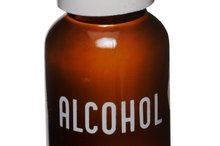What Are the Ingredients in Surgical Spirit?
Surgical spirit is a term used in the United Kingdom to describe a topical antiseptic agent similar to rubbing alcohol. Used to cleanse and sterilize skin prior to surgery, before injections or after minor injuries, surgical spirit is similar in use and function to its American equivalent, though it contains different ingredients.
Ethanol
Ethanol is a colorless, flammable liquid used in many medicinal and industrial processes, as well as in drinking alcohol. In surgical spirits, ethanol is the key component and active ingredient 2. Although it is created through the same process as drinking alcohol, ethanol is toxic because of its purity and is denatured, or chemically changed, to make it unfit for consumption. The ethanol in surgical spirits is denatured by the addition of methanol, a highly toxic liquid, creating what is referred to as methylated spirits.
- Ethanol is a colorless, flammable liquid used in many medicinal and industrial processes, as well as in drinking alcohol.
- Although it is created through the same process as drinking alcohol, ethanol is toxic because of its purity and is denatured, or chemically changed, to make it unfit for consumption.
Methanol
The Ingredients in Ultrasound Gel: Polyacrylamide Gel's Properties
Learn More
Methanol, sometimes called wood spirits, is a simple alcohol used in the production of antifreeze and gasoline. It is the denaturant most commonly added to ethanol. Surgical spirits feature a small quantity of methanol, used to render it undrinkable and therefore not subject to the heavy taxation that is applied to drinking alcohol. It is highly flammable and has a variety of negative effects on human physiology when ingested, such as blindness and respiratory failure, as well as suppressing the body's ability to oxygenate blood.
- Methanol, sometimes called wood spirits, is a simple alcohol used in the production of antifreeze and gasoline.
- Surgical spirits feature a small quantity of methanol, used to render it undrinkable and therefore not subject to the heavy taxation that is applied to drinking alcohol.
Iodoform
Iodoform is a disinfectant sometimes added to surgical spirits. Created through a chemical reaction between iodine and sodium hydroxide, iodoform is a yellowish, crystalline substance known for its strong, unpleasant odor. Though it has largely been replaced by other more effective antiseptics, iodoform is still used in several brands of surgical spirits. The odor of iodoform is sometimes referred to as "hospital smell" because of its widespread use as a disinfectant in hospitals.
- Iodoform is a disinfectant sometimes added to surgical spirits.
- The odor of iodoform is sometimes referred to as "hospital smell" because of its widespread use as a disinfectant in hospitals.
Methyl Salicylate
What Is Biafine?
Learn More
Sometimes called oil of wintergreen, methyl salicylate is a plant-based topical analgesic, or pain reliever, added to surgical spirits for its slight numbing effect. It has many medicinal and industrial applications and is added in small amounts to a variety of commercially available liniments and ointments. In addition to its pain-relieving effects, methyl salicylate is also added to surgical spirit to discourage consumption because of its bitter taste.
- Sometimes called oil of wintergreen, methyl salicylate is a plant-based topical analgesic, or pain reliever, added to surgical spirits for its slight numbing effect.
Castor Oil
Castor oil is included in the formula for certain brands of surgical spirit 2. It is obtained from the castor bean plant and has many industrial and medicinal applications. In surgical spirit, castor oil acts as a mild anti-fungal and is useful in lubricating skin as it heals. Though it is sometimes used as a food additive and an oral medicine, castor oil is dangerous if consumed in moderate to large quantities.
- Castor oil is included in the formula for certain brands of surgical spirit 2.
- In surgical spirit, castor oil acts as a mild anti-fungal and is useful in lubricating skin as it heals.
Related Articles
References
- "Ullmann's Encyclopedia of Industrial Chemistry"; Phyllis A. Lyday; 2005
- "Leung's Encyclopedia of Common Natural Ingredients: Used in Food, Drugs and Cosmetics"; Ikhlas A. Khan; 2009
Writer Bio
Samantha McMullen began writing professionally in 2001. Her nearly 20 years of experience in horticulture informs her work, which has appeared in publications such as Mother Earth News.








